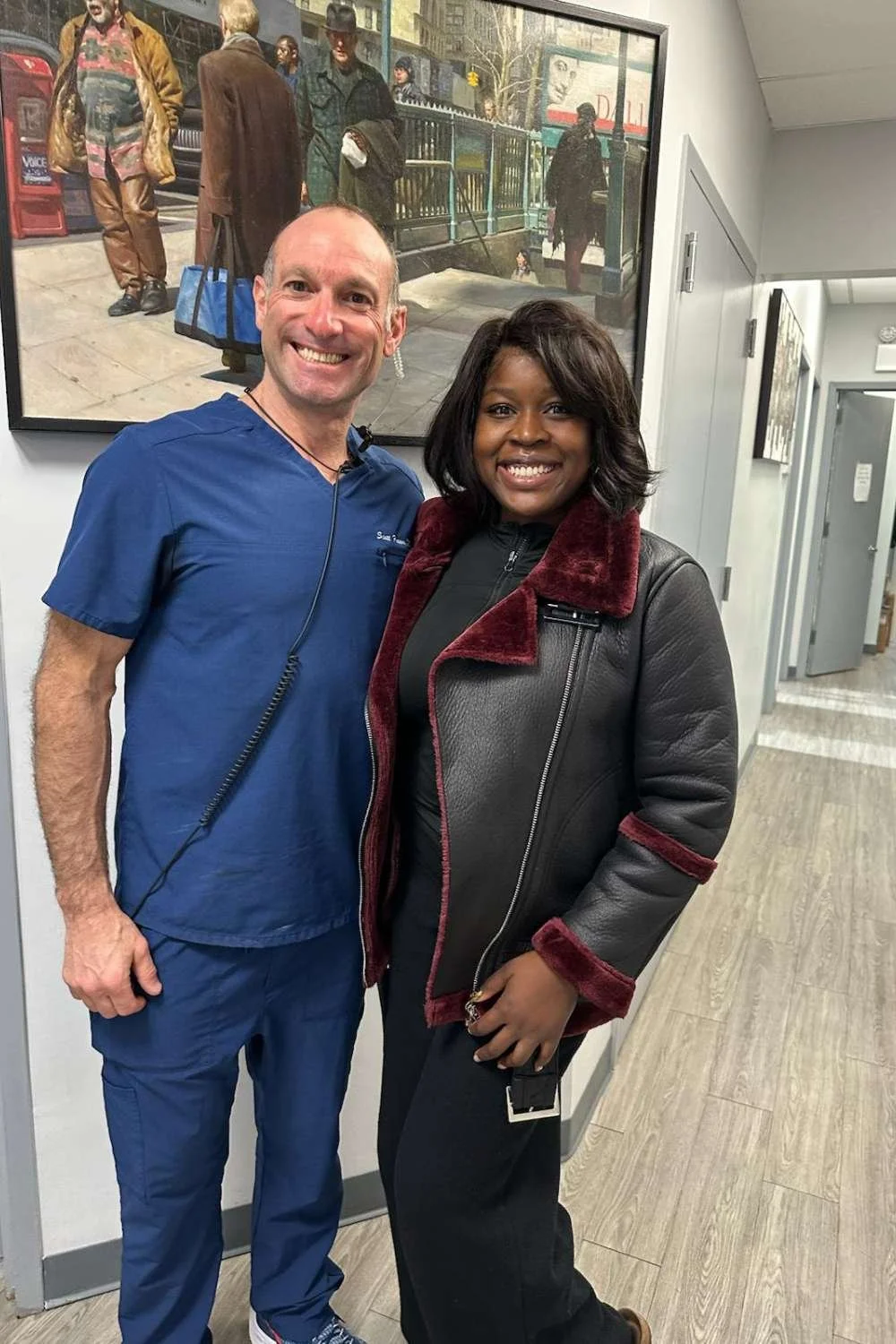Gum Grafting in Midtown Manhattan, NYC
Curious about how gum grafting can rebuild your smile without surgery?
In this short video, Dr. Scott Froum, board-certified implantologist and periodontist in NYC, explains how advanced, minimally invasive soft tissue techniques are used to treat gum recession and restore gum health.
Dr. Scott Froum provides advanced gum grafting services to patients in Midtown Manhattan and the greater NYC area. Contact us at 212-751-8530 to learn more or schedule an appointment.
Why Gum Grafting May Be Recommended
Appearance
There are times when there are cosmetic reasons to perform a gum graft. In these cases, a soft tissue graft can significantly improve the appearance of a patient’s smile, even if no active gum disease or health issues are present. When gum tissue is uneven or not providing sufficient coverage of the tooth root, it can make teeth appear longer, irregular or disproportionate. A gum graft can improve the appearance of their smile and make the teeth appear more proportionate or even, enhancing the overall harmony of the smile.
Comfort
The most common reasons to treat gum recession is to correct the effects of receding gums and reduce gym sensitivity. Gum recession can be mild and is often a natural part of aging, due to aggressive brushing or a sign of gum disease. Receding gums can expose part of the tooth root and cause sensitivity to heat and cold. Patients may choose to have a gum grafting procedure to reduce the sensitivity they are experiencing as a result of gum recession and protect the vulnerable teeth from further damage Through this procedure, patients can experience both improved comfort and enhanced long-term oral health.
Health
More often, however, gum recession is the result of periodontal disease and there are important oral health and medical reasons to perform a gum graft procedure. The recession not only affects the aesthetics of the smile and tooth sensitivity, but overall oral health and wellness. Receding gums leave the roots of teeth exposed and vulnerable to decay, instability and tooth loss, which can then lead to loss of the bone structure supporting the teeth. Gum grafts are an effective way to cover and protect the roots of the tooth, helping extend the health of the tooth and supporting bone structures. Addressing gum recession early through grafting not only restores the appearance of the smile but also strengthens the foundation of the teeth, preserving function and preventing future complications. Read about soft tissue graft aftercare here.
Frequently Asked Questions About Gum Grafting
-
Gum grafting surgery may be necessary to protect your teeth roots from cavities or further gum recession. A gum graft procedure can also improve the beauty of your smile so you do not look like you have long teeth. Gum grafts add protective tissue to your teeth roots and they can treat root sensitivity, teeth sensitivity, and root cavities since your exposed roots are softer than your teeth and more likely to get cavities. This procedure not only restores function and comfort but also improves the esthetic harmony of the smile.
-
Teeth with exposed roots that do not get the protective addition of gum grafting surgery can experience further receding gums which can make it harder to fix in the future. Exposed tooth roots are also more likely to develop cavities, leading to a higher risk of root decay, than healthy teeth because roots are softer and less mineralized than teeth. Early intervention with gum grafting is critical, as it helps prevent these more complex and severe issues from developing, preserving both the health and function of the teeth.
-
While some general dentists have training in gum grafting, gum graft procedures are typically best performed by periodontists — specialists in gum and bone surgery.
Because gum grafting can be technically challenging, choosing a provider with advanced surgical training and experience ensures the best possible outcomes. -
Yes, a gum graft is considered a surgical procedure. Traditionally, a small piece of gum tissue is taken from the roof of the mouth and used to over areas of exposed root and gum recession. This is rarely done at the office of Dr. Scott Froum. We perform minimally invasive soft tissue grafting in the majority of our cases. Newer techniques can make small incisions into the gums and use growth factors to lift the gum tissue up without having to use the roof of the mouth tissue. These innovations result in faster recovery, less discomfort, and improved patient satisfaction after gum graft surgery.
-
You may need gum grafting surgery if you’re starting to see the roots of your teeth, your teeth are becoming sensitive, your teeth are looking longer, the yellow roots of the teeth become exposed, or you don’t like the long appearance of your smile, talk to your periodontist about gum grafting surgery.These symptoms indicate gum recession, which can compromise both appearance and oral health.
Gum grafting is a common, effective treatment that restores gum coverage and helps prevent future recession.
-
When performed correctly and followed by consistent oral hygiene, gum grafts deliver long-term stability and success.
Studies show gum grafts provide long-term stability and success when aftercare is followed and the reason the gums receded in the first place are identified and corrected.
-
Yes, gum recession can be serious because if left untreated. If left untreated, it can lead to problems like infection, tooth decay, and tooth loss, among other issues. Addressing gum recession when it first begins is always the more affordable and less invasive route to take.
-
Gum recession can be reversed with gum grafts and consistent, good oral hygiene practiced at home. If the gums are already receded, it typically does not grow back without periodontal treatment. Good hygiene practices may prevent the gums from getting worse, it will not restore the gums their original position. A consultation with a periodontist is the best way to evaluate your options for restoring gum health and saving the affected tooth.
-
When gum recession occurs, spaces can form between the teeth and gum line which makes it easier for bacteria to accumulate and cavities to form. If left untreated, the gum tissue can continue to recede, potentially leading to bone loss around the affected tooth or teeth.
-
There are several causes of gum recession, including bacteria causing gingivitis and periodontal disease, teeth grinding, thin gum tissue from genetics, orthodontic movement, aggressive tooth brushing and oral hygiene habits, smoking, tobacco use, chewing hard foods that scrape the gums, biting objects that push on the gums, and many other things. Your periodontist will evaluate the specific cause as to why your gums have receded and recommend the most appropriate treatment.
Contact Us
Ready to restore your gum health and protect your smile?
Contact our Midtown Manhattan office today to schedule your appointment with Dr. Scott Froum, a leading periodontist in NYC.


